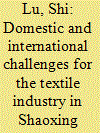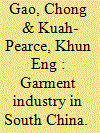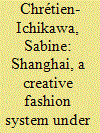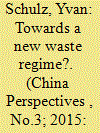|
|
|
Sort Order |
|
|
|
Items / Page
|
|
|
|
|
|
|
| Srl | Item |
| 1 |
ID:
141400


|
|
|
|
|
| Summary/Abstract |
This article recounts the transformations that have taken place in the textile industry in Shaoxing, Zhejiang Province, over the course of the past 30 years. It reveals the importance of the local setup and the links that have built up between companies, markets, and the state and its departments. It also exposes the difficulties experienced by companies as they try to adapt to their changing environment, whether in terms of opportunities offered by the domestic or international markets, or new regulations.
|
|
|
|
|
|
|
|
|
|
|
|
|
|
|
|
| 2 |
ID:
141401


|
|
|
|
|
| Summary/Abstract |
Since the implementation of China’s economic reform and opening-up policy at the end of the 1970s, garment manufacturing for both the domestic and global markets has developed and proliferated quickly in Guangzhou-centred South China. It is believed to be the result of the industrial restructuring of the global apparel commodity chain and a large domestic consumer demand from the Chinese people. Compared with other industries, the garment industry has long been subject to the strong impact of a transitional market economy and, more recently, the increasingly rapid process of marketisation in China. In order to provide a clear sociological conceptualisation of the market economy in the reform era, this paper aims to apply the relational work approach to analysing economic transactions in the garment business, particularly business dealings between garment producers and wholesalers. The focus is on their continued efforts to make appropriate economic arrangements in accordance with specific sets of social relations through continuous relational work. This paper will examine three categories of relational work and the associated economic forms in the making. First, it will explore families and the household economy; second, it will examine relatives and friends and the favour-based economy; and third, it will study strangers and the market economy. Through the use of this relational work framework, this paper will shed light on how the different sets of relational work help us to understand relationships and embeddedness between garment producers and wholesalers in China’s rapidly evolving garment economy.
|
|
|
|
|
|
|
|
|
|
|
|
|
|
|
|
| 3 |
ID:
141402


|
|
|
|
|
| Summary/Abstract |
Since the 1990s, Chinese entrepreneurs in the textile and apparel industry have confronted rapid change and increasing pressure stemming from mature foreign entrants and changing local demand. Facing multiple challenges to differentiate and keep a competitive advantage, they are being transformed into creativity-driven organisations. The transition of the Chinese clothing industry into a fashion-creating system entails a specific environment. Not only is it under construction, but its evolution may impact the global fashion economy.
|
|
|
|
|
|
|
|
|
|
|
|
|
|
|
|
| 4 |
ID:
141403


|
|
|
|
|
| Summary/Abstract |
This article explores how a multitude of entities vie for control over discarded electrical and electronic appliances in China. It analyses the strategies they deploy in order to gain or keep a competitive edge. Central government agencies, scientific research institutes, and large recycling groups, in particular, have recently joined forces with a view to redirecting flows of valuable consumer goods away from the so called “informal” sector of the economy, notably by creating high barriers to entry. They strive to distinguish themselves from small-scale recyclers by making ample use of green propaganda and narratives of technological progress. However, China’s state-sanctioned “management system” for “e-waste” recycling is not nearly as environmentally friendly as its proponents claim. It promotes a waste regime centred on "resources" – not products – and thereby contributes to accelerating and extending material cycles. Fully understanding its nature and impact requires seeing the link to other national policies, especially those promoting growth.
|
|
|
|
|
|
|
|
|
|
|
|
|
|
|
|
| 5 |
ID:
141399


|
|
|
|
|
| Summary/Abstract |
Shanghai’s modern fashion industry developed between the last decades of the nineteenth century and the 1930s and was an important step in China’s industrialisation. The present article aims to define the relationship between production and consumption in Shanghai’s modern fashion industry. One of the main characteristics of modern fashion is its ability to innovate by creating new and distinct trends while absorbing different influences. Shanghai modern fashion was an original mix of Chinese and foreign styles. The second determinant of this phenomenon is its capacity to be distinctive and reproducible at the same time. Shanghai’s modern fashion therefore only emerged when the city was able to innovate and produce goods on a massive scale that were adapted to consumer tastes. To prove this relationship, the present article establishes concrete links between traders, industrialists, and retailers. The textile industry benefited from the outcome of a complex network that linked foreign trade, cotton mills, retail shops, and mass publicity. This paper analyses how this economic network was developed.
|
|
|
|
|
|
|
|
|
|
|
|
|
|
|
|
|
|
|
|
|